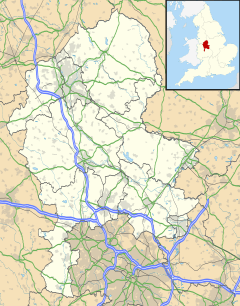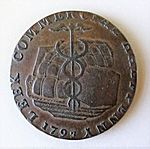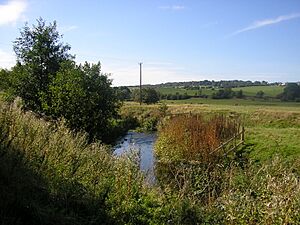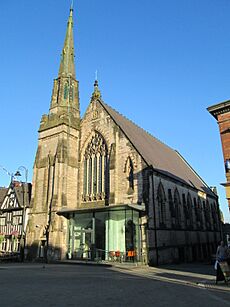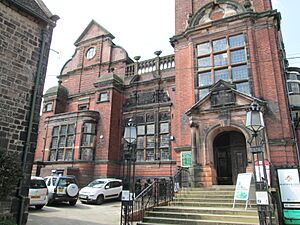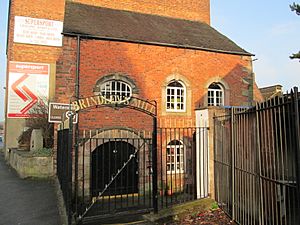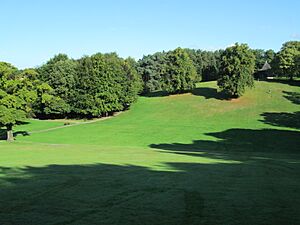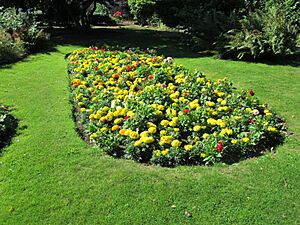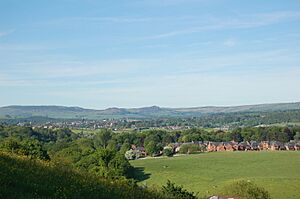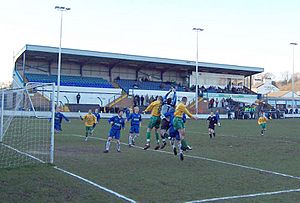Leek, Staffordshire facts for kids
Quick facts for kids Leek |
|
|---|---|
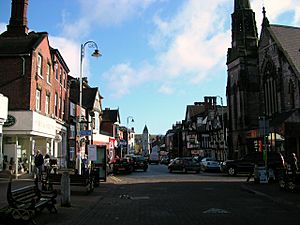 Leek town centre |
|
| Population | 20,768 (2011 Census) |
| OS grid reference | SJ984565 |
| Civil parish |
|
| District |
|
| Shire county | |
| Region | |
| Country | England |
| Sovereign state | United Kingdom |
| Post town | LEEK |
| Postcode district | ST13 |
| Dialling code | 01538 |
| Police | Staffordshire |
| Fire | Staffordshire |
| Ambulance | West Midlands |
| EU Parliament | West Midlands |
| UK Parliament |
|
Leek is a historic market town and civil parish located in Staffordshire, England. It sits by the River Churnet, about 10 kilometers (6 miles) northeast of Stoke-on-Trent. Leek is an old town that received its special royal charter in 1214, which gave it certain rights and freedoms.
Today, Leek is the main administrative center for the Staffordshire Moorlands District Council. Back in 1207, King John gave permission to Ranulph de Blondeville, 6th Earl of Chester, to hold a weekly market and a yearly fair in Leek.
The town's coat of arms has a shield with a diagonal cross, called a saltire. At the top is the Stafford knot, a symbol of Staffordshire. On either side, you can see the "Leek double sunset" (a special natural event). Below is a golden bundle of wheat, called a garb. The top of the coat of arms has a crown with three mulberry leaves on a patch of heather. A moorcock bird rests on top, holding a small weaving shuttle. The town's motto, Arte favente nil desperandum, means: "Our skill assisting us, we have no cause for despair."
Contents
What Leek is Known For
Leek has been a center for local farming for hundreds of years, with a regular cattle market. During the Industrial Revolution, it became a big producer of textiles, especially silk products. While the textile industry has now stopped, many of the old mills have been turned into homes.
Britannia Building Society used to have its main office in Leek, providing many jobs. Today, Ornua, an Irish agricultural cooperative that makes and buys butter and cheese, has its UK headquarters here. It employs over 700 people.
Leek's Location and Landscape
Most of Leek is located at least 180 meters (600 feet) above sea level. It is surrounded by the higher lands of the Staffordshire Moorlands, which are part of the southern Pennines hills.
The town is built on the side and top of a hill. Just a few miles south are the Roaches, which are tall, steep cliffs made of gritstone that rise to 505 meters (1,657 feet).
Leek is also at the edge of the Peak District National Park. Because of this, it's sometimes called the "Gateway to the Peak District" or more often, the "Queen of the Moorlands."
Weather in Leek
| Climate data for Thorncliffe (1991–2020) | |||||||||||||
|---|---|---|---|---|---|---|---|---|---|---|---|---|---|
| Month | Jan | Feb | Mar | Apr | May | Jun | Jul | Aug | Sep | Oct | Nov | Dec | Year |
| Mean daily maximum °C (°F) | 5.4 (41.7) |
6.0 (42.8) |
8.3 (46.9) |
11.3 (52.3) |
14.4 (57.9) |
17.1 (62.8) |
18.9 (66.0) |
18.6 (65.5) |
16.0 (60.8) |
12.1 (53.8) |
8.3 (46.9) |
5.8 (42.4) |
11.9 (53.4) |
| Mean daily minimum °C (°F) | 0.9 (33.6) |
0.8 (33.4) |
2.0 (35.6) |
3.9 (39.0) |
6.5 (43.7) |
9.3 (48.7) |
11.2 (52.2) |
11.2 (52.2) |
9.3 (48.7) |
6.6 (43.9) |
3.5 (38.3) |
1.5 (34.7) |
5.6 (42.1) |
| Average rainfall mm (inches) | 87.5 (3.44) |
72.6 (2.86) |
66.6 (2.62) |
59.7 (2.35) |
68.4 (2.69) |
76.5 (3.01) |
82.5 (3.25) |
82.6 (3.25) |
81.7 (3.22) |
97.5 (3.84) |
98.0 (3.86) |
101.1 (3.98) |
974.7 (38.37) |
| Average rainy days (≥ 1 mm) | 14.8 | 13.2 | 12.5 | 11.5 | 10.9 | 12.3 | 12.6 | 13.1 | 12.1 | 15.0 | 15.9 | 15.6 | 159.4 |
| Source: Met Office | |||||||||||||
Leek's Past
Leek was once part of the large lands owned by Ælfgar, Earl of Mercia. After William the Conqueror took over England, he owned Leek, as recorded in the Domesday Book. Later, it was given to the earls of Chester. One of these earls, Ralph de Blundevill, gave Leek to the abbey of Dieulacresse.
The weekly market that still takes place today started with a special permission from King John to the Earl of Chester. In the 17th century, this market was very important.
The silk manufacturing industry in Leek began in the late 1600s. It is thought that some Huguenots (French Protestants) who settled in Leek after being forced out of France helped this industry grow. In the 17th and 18th centuries, Leek was also known for its ale (a type of beer).
Prince Charles Edward Stuart, also known as Bonnie Prince Charlie, passed through Leek in 1745 during his march towards Derby and again on his way back to Scotland.
Buildings and Design
Leek has many interesting buildings, including the old parish church, St Edward the Confessor's, and a beautiful Victorian church, All Saints', designed by Richard Norman Shaw. Many other Victorian buildings still stand in the town.
The Sugden Family's Impact
Many of Leek's buildings were designed by the Sugden family, who were architects. William Sugden came to Leek in 1849 to design railway stations for the Churnet Valley Railway. His son, Larner Sugden, joined him in 1866, and they formed the famous company "Sugden & Son (Architects)." Their office building is still in Leek today. Larner was very keen on protecting old buildings, which helped Leek grow while keeping its historic feel.
The Sugden family designed many different types of buildings. Some of their notable works include:
- The Congregational Church (now Trinity Church), built in 1863 in the Gothic Revival style with a tall 40-meter (130-foot) spire.
- Myatt's Mill in Earl Street (1864).
- Mill Street Methodist Chapel and Ragged School (1870).
- The Cottage Hospital, built in memory of silk maker James Allsop (1871).
- Their own houses in Queen Street (1877).
- West Street School (extended in 1881).
- The District Bank (1882).
- The Leonard Street Police Station in Scottish baronial architecture style (1891).
Perhaps their most famous work is the Nicholson Institute, built in 1882 in the Queen Anne style. This building is cleverly placed behind an older 17th-century building called 'Greystones'. Larner Sugden didn't want to knock down the old building, so he built the institute behind it. He also included busts (sculptures of heads) of famous people like Shakespeare, Newton, Reynolds, and Tennyson on the building. These represent literature, science, art, and poetry from the 16th to the 19th centuries.
In 1899, the Technical Schools and the Co-operative Society Hall were built. The old cattle market in the town center was replaced by a bus station and shopping centre in the 1960s. A new cattle market was built on the edge of town near the railway station. Later, this station closed, and a supermarket now stands there.
The Nicholson War Memorial was opened in 1925 to honor those who died in wars. Leek also has some newer buildings, like the updated Trinity Church (2011) and a new teaching building for Leek College (2013).
Famous People from Leek
Leek was home to James Brindley, an 18th-century engineer who built canals. He built a water-powered corn mill in 1752, which is now the Brindley Water Mill and Museum.
William Morris, who started the Arts and Crafts movement, often visited Leek between 1875 and 1878. He learned about dyeing from Thomas Wardle, who owned a dye factory in the town. Leek also supplied silk for Morris's company.
Other notable people connected to Leek include:
- Dame Averil Cameron, a history professor at the University of Oxford.
- Dave Hill, the singer for the band Demon, who lives in Leek.
- James Ford, a music composer and producer for bands like Simian Mobile Disco, who grew up in Leek.
- Eric Bristow, a famous darts champion, used to live in the town.
- Anna Watkins, born in Leek, won a gold medal in rowing at the 2012 Olympics.
- Kim Barnett, a former England test cricketer, was born and lives in Leek.
Things to See and Do
In Leek Town
Leek's "Double Sunset" is a special event that brings many visitors, especially around the summer solstice. This happens when the sun sets behind the Cloud hill, then partly reappears in a dip in the hill before setting again. You can see this phenomenon from Lowe Hill or from the private road to Pickwood Hall.
Every May, the Leek Arts Festival takes place, celebrating the town's culture. It started as a weekly event but now lasts a whole month.
In 2013, Leek came second in the Telegraph's "High Street of the Year" competition.
Parks and Gardens
Leek has several parks and open spaces. These include Westwood Recreation Ground and Woodcroft Recreation Ground to the west, and Pickwood Recreation Ground to the east.
Brough Park is just north of the town center. It has beautiful gardens, paths, different types of trees, and a lake. The park started in 1913 when a local businessman, W. S. Brough, gave land to the town council. The park officially opened in 1924. It has tennis courts, a bandstand, a bowling green, and swimming baths.
North of the park is Brough Park Fields Nature Reserve, which has meadows and young woodland with walking trails and views towards the Roaches.
Birch Gardens is a public garden in Leek with flower beds, grassy areas, and paths. It was created in the 1930s and opened in December 1935 to celebrate the silver jubilee of King George V and Queen Mary.
In 2018, Birch Gardens was named a Centenary Field to remember those who died in World War I, helping to protect it as a public space forever.
Around Leek
Nearby Rudyard Lake is a popular spot for tourists and is home to the Rudyard Lake Steam Railway, a small train that runs along its eastern side. Other attractions nearby include the local football club Leek Town F.C., Alton Towers theme park, and the Peak District National Park.
The Churnet Valley Railway at Cheddleton is a heritage railway that attracts many visitors. There are plans to extend this railway back into Leek itself.
The beautiful countryside of the Staffordshire Moorlands and the Peak District makes the area a great place for tourists. Just outside Leek is Peak Wildlife Park, known for its many birds. Also nearby is Coombes Valley RSPB reserve, a nature reserve with walks through a wooded valley. Deep Hayes Country Park, built around an old reservoir, is also a short distance away.
Getting Around Leek
Buses
Leek has bus services provided by First Potteries. There are regular buses to Hanley and other nearby towns like Buxton and Macclesfield.
Trains
Leek no longer has its own national railway station. The closest one is at Congleton, for local trains to Manchester and Stoke-on-Trent. From Stoke-on-Trent, you can catch inter-city trains to London and Manchester.
The old Leek railway station opened in 1849 but closed in 1965. The station building was taken down in 1973, and a supermarket now stands there.
Heritage Railways
The Churnet Valley line now operates as a heritage railway south of Leek. Trains run between Kingsley & Froghall and Ipstones.
Another section of old track is used by the Rudyard Lake Steam Railway, a small tourist train that runs next to Rudyard Lake northwest of Leek.
Future Plans
There are plans to build a new station about 800 meters (half a mile) south of the original site. This is part of a bigger project called Reconnect Leek to develop the Barnfield area as a tourist spot. There are also proposals to reopen the Stoke-Leek line, which was once used only for goods trains.
Local News and Radio
Local TV news for Leek is provided by BBC West Midlands and ITV Central. You can also receive BBC North West and ITV Granada.
Local radio stations include BBC Radio Stoke, Hits Radio Staffordshire & Cheshire, Greatest Hits Radio Staffordshire & Cheshire, and Moorlands Radio, which is a community radio station based in Leek.
The Sentinel is the local newspaper for the town.
Sports in Leek
Leek has four football clubs. Leek Town F.C., founded in 1946, plays at Harrison Park. They were champions of the Northern Premier League in 1997. Leek CSOB, founded in 1945, also plays at Harrison Park. Ball Haye Green FC, founded in 1880, plays in the Staffordshire County Senior League. In 2016, Staffordshire Moorlands FC was also started in the town.
Leek Hockey Club is on Macclesfield Road. They have a clubhouse and pitches, and play league matches at Leek High School and Westwood College. Famous players like Olympic gold medalist Imran Sherwani have played for the club.
Leek Cricket Club is also located on Macclesfield Road.
Leek Archery Club uses the Macclesfield Road site for outdoor shooting and has an indoor range in town.
Leek RUFC (Rugby Union Football Club) is named after the town but is based in nearby Cheddleton.
There are also other sports clubs in the area for Tennis, Swimming, Bowls, and Sailing.
Twin Town
Leek is twinned with:
- Este, Italy
Schools in Leek
Leek uses a three-tier school system, meaning students go to first schools, then middle schools, and finally high schools or colleges.
- All Saints' Church of England First School
- Churnet View Middle School
- St Edwards Middle School
- Leek High School
- Westwood College
- Westwood First School
- Leek School of Art, which is part of Buxton & Leek College
St. Edwards Academy (formerly St. Edwards Middle) is the largest middle school in Staffordshire.
See also
 In Spanish: Leek (Staffordshire) para niños
In Spanish: Leek (Staffordshire) para niños


